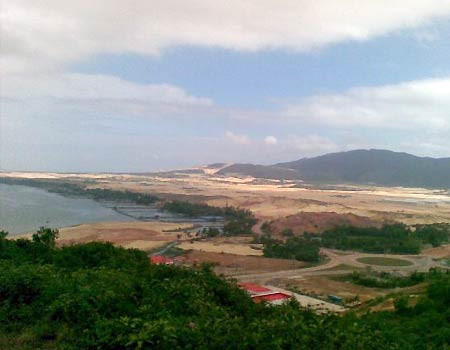Gigantic Victory Nhon Hoi oil refinery downsized
 |
Ho Quoc Dung, Chairman of Binh Dinh provincial People’s Committee, last week said that the developers, leading Thai petroleum group PTT and Saudi Aramco, have just announced that they might reduce the project’s capacity in a break from their original plan.
The project’s investment was set below $22 billion, with a production capacity of 400,000 barrels per day (bpd), lower than the $28.7 billion in investment and 660,000 bpd capacity initially proposed by the developer in November 2012.
However, Dung added that the investors were withholding their decision until June 2016, when they would comment in detail on the scale and progress of the project.
The adjustments came after the investors hired experts – including some from the Vietnam Petroleum Institute – to make further assessments on project restructuring to take into account the context of global oil prices, which have experienced a deep nosedive.
Nguyen Ngoc Toan, deputy head of Nhon Hoi Economic Zone Management Authority, told VIR that the future of the project would be decided in the coming meeting with provincial authorities and investors. The province would work with ministries to recalculate preferential rates in the context of unexpectedly low oil prices if they choose to continue developing the project. If they do not, authorities must allow other investors the chance to use the land set aside for Victory Nhon Hoi for their industrial and tourism projects instead.
Many other projects are in the same boat, as low oil prices have decreased the incentive for investors to move forward with their multi-billion-dollar oil refinery projects in Vietnam.
For instance, the future of the Long Son petrochemical project in the southern province of Ba Ria-Vung Tau is uncertain, as Qatar Petroleum, one of the four investors involved in the $4.5-billion project, pulled out last year.
Meanwhile, the city of Can Tho’s Planning and Investment Department is considering asking municipal authorities to revoke the licence granted to a $538 million Can Tho oil refinery project because of the investor’s slow implementation of the project.
Although Vietnam has about 10 oil refinery and petrochemical projects with the potential to produce more than 60 million tonnes of oil per year, only Dung Quat in the central province of Quang Ngai is currently operational.
Aside from Dung Quat, other refinery and petrochemical projects will rely on crude oil supplies from the Middle East, Africa, and Latin America, making fuels produced in Vietnam less competitive.
What the stars mean:
★ Poor ★ ★ Promising ★★★ Good ★★★★ Very good ★★★★★ Exceptional
Latest News
More News
- Ho Chi Minh City backs $2 billion AI data centre with dedicated task force (January 06, 2026 | 08:43)
- PM sets January deadline for high-speed rail consultant (January 06, 2026 | 08:40)
- New decree spurs on PPP implementation (December 31, 2025 | 19:01)
- Global alliance develops $1 billion AI data centre network in Vietnam (December 30, 2025 | 10:08)
- Standing out in the Chinese outbound investment wave (December 29, 2025 | 10:29)
- Bright spots obvious in foreign investment mission (December 29, 2025 | 09:00)
- Ho Chi Minh City hits $8.37 billion in FDI (December 29, 2025 | 08:28)
- Vietnam and UK cooperation backs finance talent for IFCs (December 27, 2025 | 16:31)
- Global partnerships key to Vietnam’s IFC development (December 26, 2025 | 16:18)
- Vingroup pulls out of bid to invest in North-South high-speed railway (December 26, 2025 | 11:42)

















 Mobile Version
Mobile Version